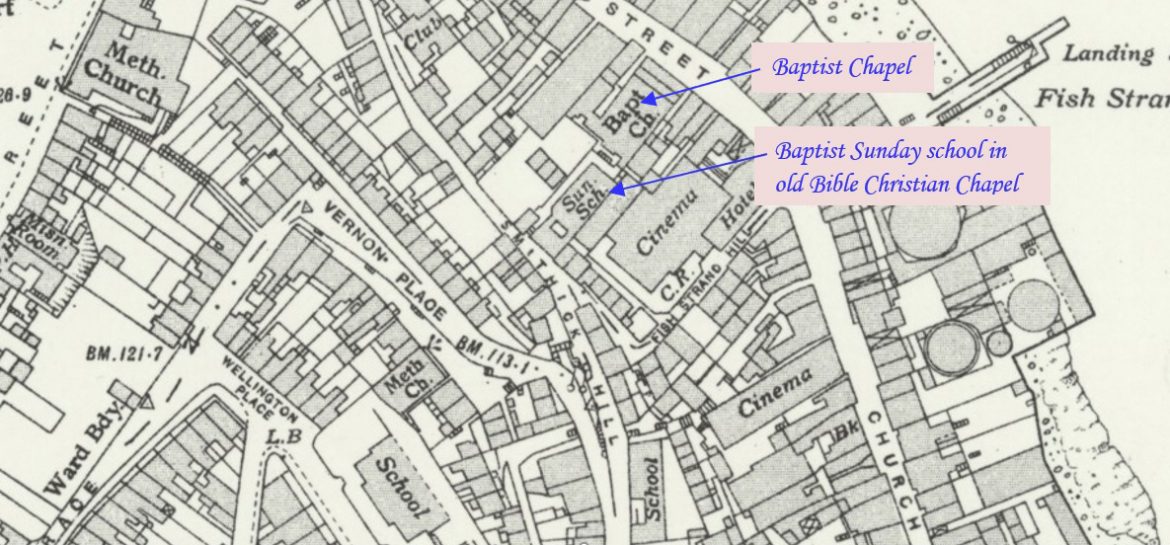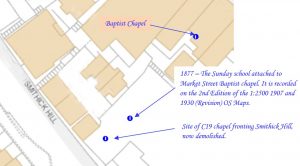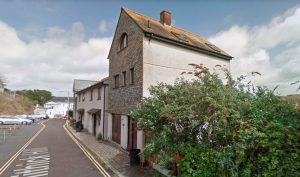
Falmouth is a town, civil parish and port on the River Fal on the south coast of Cornwall. This profile of Smithick Hill Bible Christian Chapel has been compiled by Jo Lewis and Tony Mansell.
 (Cornwall County Heritage Gateway)
(Cornwall County Heritage Gateway)
Smithick Hill was also known as Parram hill and Fish Street Hill. (The Rise of Provincial Jewry by Cecil Roth. https://www.jewishgen.org/jcr-uk/susser/provincialjewry/exeteripsw.htm)
“The road today has had most of its houses demolished and turned over to car parking areas so tracing the exact site of this first BC chapel at Falmouth is not easy, using Google Street View, as so much has vanished over the years. I cannot find any Falmouth map of the right time scale here to indicate its precise position in the street.” (David Thomas of Kresen Kernow)
Circa 1830: According to Heritage Gateway there was a Bible Christian chapel in Smithick Hill, Falmouth. It had stucco detail and pediment to front end and pedimented porch, round-arched window openings. (Cornwall Council Heritage Gateway) This does sound like the nearby Primitive Methodist Chapel so maybe an error?
1830 Bible Christian Chapel built on Smithick Hill. (Miss Susan Gay’s Falmouth chronology)
1821: Falmouth Circuit formed. 1835: Became part of the Gwennap Circuit. 1864: In the Hicks Mill Circuit. 1881: Falmouth and Penryn Circuit formed. (A Dictionary of Methodism)
17 Aug 1836: Assignment of lease, Providence Bible Christian Chapel, Falmouth. Parties: 1) Charles Blake, Bible Christian minister, of Gwennap 2) William Mason of Gwennap, Richard Vickery of Breage, Thomas Hill of the Borough of Truro and Robert Kent of the parish of Veryan, Ministers in the Bible Christian Connexion, Thomas Sims of St Day in Gwennap, and Jacob Corin Edwards of the Borough of Truro, ironmonger, William Berryman, miner, of Gwennap, John Courties, of the Borough of Penryn, gardener, and Anthony Davey, of Falmouth, blacksmith, Trustees. Recites lease of 1 December 1834 of a plot of ground of 30 by 49 feet situate at or near the Back Hill and at the upper end of a yard or cartilage belonging to a certain dwelling house and premises demised by John Lord Wodehouse to Richard Olivey and by him assigned to John Drew deceased, together with the chapel then lately erected on the said plot of ground (Kresen Kernow MRF/547) Back Hill is probably an old or local vernacular for that area behind the docks.
The Bible Christian cause in Falmouth was weak. A chapel, opened in Smithick Hill in August 1835, was faced with closure in 1850, but replaced by Berkeley Vale chapel in 1867 (A Dictionary of Methodism)
Closure date not found but could possibly have coincided with Berkeley Vale Bible Christian Chapel opening in 1867.
“The former Bible Christian Chapel on Smithick Hill was bought to use as a Sunday school” – by the Baptists. (Falmouth Conversation Area Appraisal https://map.cornwall.gov.uk/reports_conservation_areas/Falmouth%20-1989.pdf)
1867: Soup kitchen for Falmouth at the Old Ebenezer Chapel…” (Lake’s Falmouth Packet and Cornwall Advertiser – Saturday 21 December 1867) Ebenezer would seem to relate to a Baptist building which, by then, it probably was.
1869: Falmouth Soup Kitchen “… was opened on Tuesday last at the old Bible Christian Chapel, Smithick Hill…” (Lake’s Falmouth Packet and Cornwall Advertiser – Saturday 18 December 1869) Although held in the old Bible Christian Chapel, it appears to have been run by an independent committee but not continuously at this location.
1880: Building shown as a soup kitchen. (old-maps.co.uk)
1892: There was a soup kitchen in Smithick Hill on map.
Site of C19 chapel fronting Smithick Hill, now demolished. During an excavation, its truncated south-west front and south-east side walls were recorded to have survived to 2.5m high, with remains of internal plaster with inscribed ashlar lines. A dressed granite foundation stone was also found during the excavation, bearing the inscription ‘MEMORIAL STONE/LAID BY/ J.C. DOWNING ESQ. MAYOR/ JUNE 17. 1881’. This is presumed to have been laid into the front wall of the chapel (1). (Cornwall Council Heritage Gateway) This report is suspect as the 1881 date does not fit, nor does an alleged demolition date. David Thomas says, “A Joseph Chesterfield Downing was certainly around in Falmouth in the 1880s and the 1890s, but this certainly does not make sense in respect of a chapel that was abandoned there in the 1860s for BC worship. It may well be that the Heritage Gateway is wrong, and they dug up some other building instead, or the old chapel building had another use or an extension in 1881.” It may have been the foundation stone of the Baptist Sunday school built between 1880 and 1907.
 The tall building is named Chapel – Could it have been the location of the soup kitchen or perhaps near it?
The tall building is named Chapel – Could it have been the location of the soup kitchen or perhaps near it?
